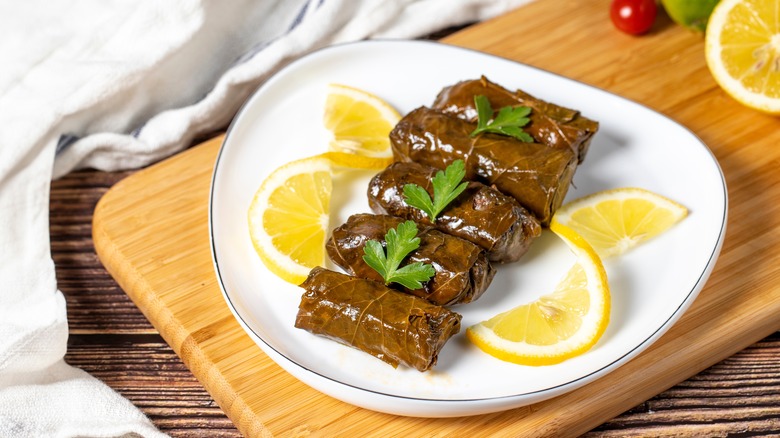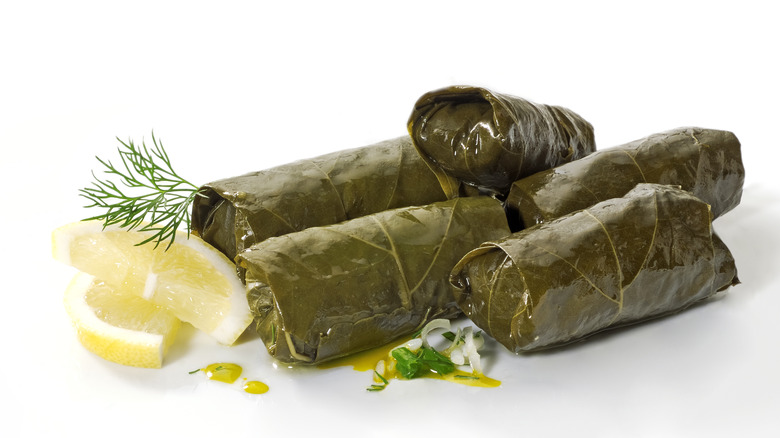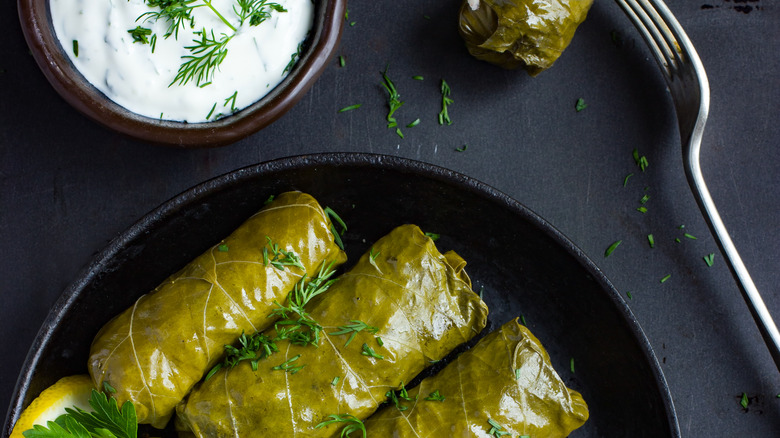The Right Way To Eat Canned Dolmas For The Uninitiated
If you thought dolmas (also known as dolmades or dolmadakia) were reserved for ancient Dionysian feasts, think again — these stuffed grape leaves can likely be found canned in your local supermarket. You're not wrong in thinking these delicacies have a myth-like quality to them, however. According to Greek legend, they were enjoyed as part of a wider diet including nectar, ambrosia, and other lavish foods by the gods on Mount Olympus. A less grandiose belief is that they were borne out of necessity during the siege of Thebes by Alexander the Great — food in the Greek city was in short supply, so people began wrapping small pieces of meat in vine leaves to make it go further.
Dolmas are found in other areas of the world, including the Middle East, with each country offering its own history and flavor variations, but all share the same basic foundation — grape leaves wrapped around savory fillings made from ingredients like rice and herbs; some are even stuffed with ground meat. Canned dolmas follow the same formula with some discrepancies between fillings (some use quinoa in place of rice, for example). They may be one of the ultimate convenience foods, but there are still a few things to keep in mind if you want to enjoy this preserved snack with ease.
When to rinse canned dolmas and how to store them
Some canned dolmas come in a salty brine, which improves their texture and imparts extra flavor. It's therefore important to give them a quick rinse to eradicate any excess sodium or brackishness. Simply drain off the liquid, pop the dolmas in a colander or sieve, and run a little cool water over the top. Be sure to do this gently, as the leaves are delicate and can easily split or even come apart completely if not handled carefully.
The stuffed variety of canned dolmas is commonly preserved in oil rather than brine. In this case, you can drain the bulk of the liquid and forgo rinsing the dolmas altogether. The oil here is often infused with additional ingredients like herbs or hot sauce, so it makes sense to retain some of it for flavor's sake.
If you're not planning on eating canned dolmas in one sitting, it's important to store them in the correct manner. This means placing them in a tightly sealed food-safe container in the fridge, along with any liquids to prevent them from drying out (something to keep in mind if you're using dolmas that require rinsing). When stored in this way, they can be safely eaten for up to four days after opening. On that note, the unopened cans can be stored in a cool, dry place, away from direct sunlight for approximately a year.
Delicious ways to enjoy canned dolmas
Canned dolmas are certainly flavorsome in their natural state, but they can very easily be elevated into something special. Some of the simplest ways to zhuzh up these treats are to serve them with a bowl of cool and creamy tzatziki (or other dip of your choosing), give them a quick zap in the microwave, or heat them in a covered dish in the oven, followed by a squeeze of lemon juice or a drizzle of tahini (or both). You could also carefully chop them up and add them to pita or a salad of lettuce, tomato, cucumber, red onion, feta, tabbouleh, and other compatible ingredients.
Some cooks even add dolma to hearty soups, while others bread and fry them! But if you really want to take your grape leaf-eating to the next level, consider adding these cylindrical snacks to a cheeseboard or a mezze platter alongside pita, hummus, and olives — plus a cheeky glass or two of wine. We're suddenly feeling some serious Dionysian feast vibes, how about you?


